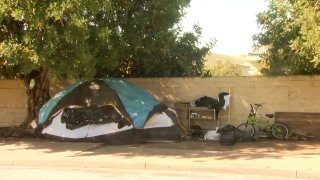
San Jose has the fourth highest number of homeless people per capita in the U.S. based on a recent survey, and advocates blame it on multiple problems.
An Insider Monkey report shows that for every 100,000 people per capita, San Jose has 363 residents who are homeless. New York City ranks third, Los Angeles ranks second and Eugene, Oregon took the top spot out of 25 cities. Advocates and experts said the problem is multifold with organizations working in silos, the lack of affordable housing and soaring rents as the key issues.
In a county where the average asking rent for a two-bedroom apartment is $3,000 per month, that would mean an entire paycheck for someone working minimum wage.
"We know that housing prevents homelessness, and we don't have enough of the deeply affordable housing that our residents need to stay stable and safe," Ray Bramson, chief operating officer of Destination: Home and San Jose Spotlight columnist, told San Jose Spotlight.
Approximately 4,297 new households experienced homelessness for the first time last year, a 24% jump from the 3,473 households reported in 2022. San Jose is home to 6,340 homeless people and the county tallied 9,903 unhoused people in its 2023 point-in-time count, a biennial survey of the region's homeless residents. And despite efforts, for every family the county houses, nearly two households become homeless.
According to the 2023 Homeless Census and Survey, 24% of people became homeless after losing their job, followed by 11% who became unsheltered due to alcohol or drug use. Major events such as a medical expense, losing a month's worth of income or an accident could cause a family to spiral into homelessness.
In San Jose roughly one-third of the homeless population is unable to work, 41% are looking for employment and 28% are not looking for work at all, according to the 2022 homeless census report.
Local
The lack of coordination between various services providers and the city's inability to measure the effectiveness of its programs also poses problems in tackling homelessness effectively.
Todd Langton, executive director of homelessness nonprofit Agape Silicon Valley, said too often organizations are working independently of each other and there is not enough accountability with how money is being used.
Get a weekly recap of the latest San Francisco Bay Area housing news. Sign up for NBC Bay Area’s Housing Deconstructed newsletter.
"The county's and the city's approach is extremely dysfunctional. We deserve to be No. 4," Langton told San Jose Spotlight. "In Santa Clara County, you have hundreds of different silos of agencies and nonprofits, working separately from each other without any oversight and without having to report to upper management so to speak."
San Jose Councilmember Dev Davis said characterizing the city and county as working in silos isn't a fair characterization of what's been happening over the last 18 months.
"We have built thousands of units, thousands more are in the pipeline. We have a number of interim housing sites, and we're looking at safe sleeping sites, how to do them and where," Davis told San Jose Spotlight. "I don't know a city councilmember who doesn't wake up every day and think about homelessness and the issues that arise around homelessness, such as trash and sanitation, and try to figure out a new, better way to to ameliorate the problem."
San Jose Mayor Matt Mahan declined to comment for this story.
The California State Auditor in April found San Jose could not identify all of its expenditures on homeless support services, nor does it adequately measure the effectiveness of its systems. It also found that most of the city service providers have not yet received a performance report, despite costing the city millions of dollars in contracts.
The city also lacks enough temporary or permanent housing to keep up with the demand, and auditors recommended city officials collect data on temporary housing immediately -- which the audit found missing.
Langton points to how wasteful it is for the city to sweep encampments without first giving people a place to live, pushing homeless individuals to another part of the city who later might return to the same spot that was swept.
"It's a waste of time and money and it causes so much stress and hardship on the homeless person," Langton told San Jose Spotlight.
One city that has been effective in reducing homelessness is Houston, Texas -- a model San Jose should follow more closely, Langton said.
In 2011, Houston had one of the largest homeless populations in the country, with more than 8,000 people experiencing homelessness. The next year the city implemented an aggressive strategy to put people in affordable permanent housing and subsidized rents, shifting away from building shelters. They also streamlined service providers under one umbrella organization, The Way Home, run by the Houston Coalition for the Homeless.
More than a decade later, Houston has reduced its homeless population to 3,200 people, down 62%, and housed more than 30,000 people.
However, the main difference between Houston and San Jose is the cost of living, Bramson, who has traveled to Houston and spoken to the key players there, said.
"I think it's essential that we continue to respond to the crisis on our streets and the people suffering everyday," Bramson told San Jose Spotlight. "But if we don't address the underlying issues, and that's the lack of affordable housing, it's going to be hard for us to make a change in the long-term."
Editor's Note: This story was originally published by San Jose Spotlight.



